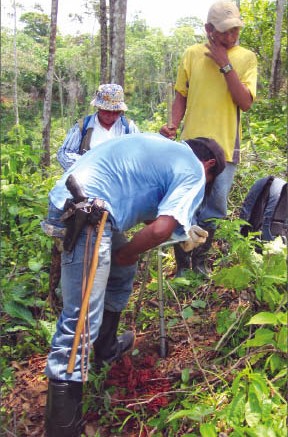FDG Mining (FDG-V) is proving up resources at the past-producing Topacio gold-silver concession in central-eastern Nicaragua with an ongoing, two-phase drill program.
The junior started six years ago as a private, Vancouver-based company exploring Nicaragua. Three years later it became enamoured with the potential at the 93-sq.-km Topacio property.
Topacio sits in one of five main gold-mining districts in the country, and covers the entire known district of Topacio, which saw little modern exploration until FDG arrived.
Daniel Farrell, who took over the company’s reins as president and CEO last November, says that what makes the project attractive is its known gold-silver resource.
“We think it can be expanded pretty dramatically here with our drill programs within the next year,” he says. “That’s number one.”
Farrell notes that the site is readily accessible, with the closest large town — Muelle de los Bueyes, which has a population of 30,000 — only 12.5 km away.
The company has set up an exploration office in Muelle, and has two expatriate geologists and four Nicaraguan geologists on the ground. The company also has a corporate office in the capital city of Managua.
The property has a similar geological setting to B2Gold’s (BTO-T) nearby La Libertad and El Limon mines and contains 11 northeast-trending, steeply dipping epithermal quartz veins, of which six have been previously mined. The showings were uncovered in the 1890s and mostly mined in the early 1900s. It is estimated that 160,000 tonnes grading 8 grams gold and 80 grams silver per tonne were recovered from underground workings on the Mico, Salmeron and Lone Star veins.
Two main modern drill programs were completed at Topacio: one in 1984 by a Brazilian company called Companhia de Pesquisa de Recursos Mineirais (CPRM), and the other between 1995 and 1996 by Vancouver-based Triton Mining.
Following Triton’s program in the mid-1990s, efforts to advance the project were abandoned owing to a poor gold market. No work was done on the property until FDG walked onto the scene in 2009.
In April 2010 FDG signed a definitive, three-year option with Iversiones Mineras (IMISA) to buy Tapacio by paying US$3 million before April 30, 2013. The junior also agreed to make semi-annual payments of US$60,000 to the Nicaraguan company until the option is exercised. IMISA has a 3% net smelter return royalty on Tapacio’s production.
FDG went public in May 2011 to help fund exploration, offering 3.7 million shares at 25¢ apiece, for gross proceeds of $948,500.
Previous operators CPRM and Triton estimated the project had a non-compliant, global resource between 260,000 oz. gold and 1.3 million oz. gold grading an average of 6 grams gold,with associated silver.
Looking to verify a compliant resource, FDG commissioned a National Instrument 43-101 technical report that was completed last February. Using a 3-gram gold cut-off, the report outlined an inferred resource on the Topacio vein of 680,000 tonnes averaging 5.2 grams gold and 34 grams silver, for 114,000 oz. gold and 743,000 oz. silver. The resource was based on Triton’s 26 drill holes in the vein.
Early last December the junior started a two-phase diamond drill program to confirm Triton’s drilling and expand the resource at depth and along strike. The program contains 26 holes and 18 have been completed so far, Farrell says.
On March 14 FDG released its five latest assays, with four drilled below the inferred resource. The holes extended mineralization at depth by another 60 metres.
The resource is open along strike to the northeast and southwest. At its deepest, the inferred resource extends 200 metres at depth and is still open.
The program will also test high-grade gold mineralization that the company identified through trenching that cut the Brasil and Mico veins, which run parallel to the main Topacio vein.
Farrell says the ongoing program should wrap up in April, after which the company will launch a 10,000-metre program to continue testing Topacio and the nearby veins.
The company has $1.2 million in cash-on-hand and is looking up to $3 million in the near future to better delineate Topacio’s potential.
“We think, with the combination of veins in there, that developing a 1-million-oz. resource is certainly within reason. You know, some people think, ‘Oh my goodness, you should be able to develop much more than that’ . . . but I don’t think it’s fair to say that there’s 3 million oz. there at this time. I don’t think that is reasonable. But to develop a million-ounce resource — I think that’s certainly obtainable, and can be done,” Farrell says.


Be the first to comment on "FDG keeps exploring Topacio in Nicaragua"